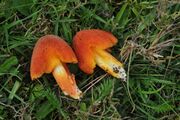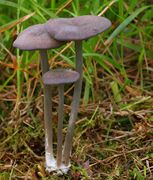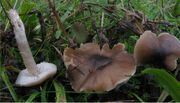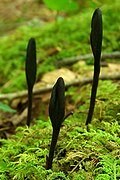Waxcap grassland
Topic: Earth
 From HandWiki - Reading time: 6 min
From HandWiki - Reading time: 6 min
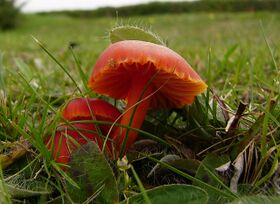
Waxcap grassland is short-sward, nutrient-poor grassland that supports a rich assemblage of larger fungi, particularly waxcaps (species of Hygrocybe and related genera), characteristic of such habitats. Waxcap grasslands occur principally in Europe, where they are declining as a result of agricultural practices. The fungal species are consequently of conservation concern and efforts have been made in the United Kingdom and elsewhere to protect both the grasslands and their characteristic fungi. Over 20 species of European waxcap grassland fungi are assessed as globally "vulnerable" or "endangered" on the IUCN Red List of Threatened Species.[1]
Background
The association of waxcaps with unimproved (nutrient-poor) grasslands was first noted in 1949 in the Netherlands,[2] but current interest was stimulated by a series of papers published by Dutch mycologist Eef Arnolds in the 1980s.[3][4] Arnolds not only confirmed the association of waxcaps with unimproved grasslands, but also noted the rapid decline in such habitats in the Netherlands.[4] Similar studies were subsequently undertaken elsewhere in Europe, initially in Denmark[5] and the United Kingdom.[6]
Definition and description
Waxcap grasslands are characterized by being unimproved (unfertilized and nutrient-poor), short-sward (through grazing or mowing), moss-rich, and long-established (not recently sown).[7][8] They occur in both upland and lowland areas and may be on acidic, neutral, or calcareous soil. They support a wide range of characteristic larger fungi, but may not be equally species-rich in plants.[7]
Characteristic species
Larger fungi characteristic of waxcap grasslands include agarics (gilled mushrooms) belonging to the genera Cuphophyllus, Gliophorus, Gloioxanthomyces, Hygrocybe, Neohygrocybe, and Porpolomopsis (waxcaps), Entoloma (pinkgills), Dermoloma, Pseudotricholoma, Camarophyllopsis, and Hodophilus; clavarioid fungi (club and coral fungi) belonging to the genera Clavaria, Clavulinopsis, and Ramariopsis; and earthtongues belonging to the genera Geoglossum, Glutinoglossum, Microglossum, and Trichoglossum.
The "CHEG" or "CHEGD" assessment system
In 1995, Rald proposed a simple count of the number of waxcap species present at a given site in order to assess its value as a waxcap grassland. He suggested that the presence of 17 or more species meant the site was of national importance, 9-16 species of regional importance, 4-8 species of local importance, and 3 or fewer of no importance.[5] This system was modified by Rotheroe and others to include all the characteristic macrofungi and not just waxcaps.[6]
Known as the "CHEG" system, this is widely used in survey work today. The acronym "CHEG" stands for the main groups of relevant fungi: C - the clavarioid species (club and coral fungi); H - species of Hygrocybe and related genera (waxcaps); E - Entoloma species (pinkgills); and G - the geoglossoid fungi (earthtongues). More recently the modified term "CHEGD" has been used to include species of Dermoloma, Pseudotricholoma, Camarophyllopsis, and Hodophilus which also inhabit these grasslands.[9]
Conservation
The past 75 years have witnessed a loss of more than 90% of unimproved grasslands in western Europe, mainly due to agricultural intensification[10] through ploughing and reseeding, manuring, and the application of fertilizers and other chemicals.[4][7] The maintenance of a short sward by grazing or mowing (and removal or cuttings) has also been shown to be important for fruiting of waxcaps, with haycutting in July, followed by aftermath grazing/mowing to 3 cm having found to be optimal.[8] In 1988, Arnolds estimated that only some 200 ha of unimproved waxcap grasslands remained in the Netherlands.[3]
As a result, both the unimproved, nutrient-poor grasslands and the larger fungi typical of such grasslands are of conservation concern, with 23 waxcap-grassland species currently assessed as globally "vulnerable" or "endangered" on the IUCN Red List of Threatened Species.[1]
Globally threatened waxcap-grassland fungi
| Image | Scientific Name | English Name | Current IUCN Red List Status |
|---|---|---|---|
 |
Clavaria zollingeri | Violet Coral | vulnerable |
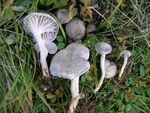 |
Cuphophyllus canescens | Felted Waxcap | vulnerable |
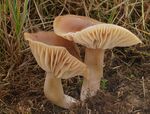 |
Cuphophyllus colemannianus | Toasted Waxcap | vulnerable |
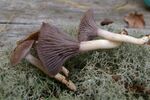 |
Cuphophyllus lacmus | Grey Waxcap | vulnerable |
| Cuphophyllus lepidopus | Scalyfoot Waxcap | vulnerable | |
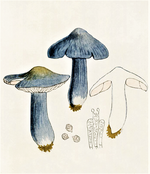 |
Entoloma bloxamii | Big Blue Pinkgill | vulnerable |
 |
Entoloma griseocyaneum | Felted Pinkgill | vulnerable |
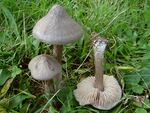 |
Entoloma porphyrophaeum | Lilac Pinkgill | vulnerable |
 |
Entoloma prunuloides | Mealy Pinkgill | vulnerable |
| Gliophorus europerplexus | Butterscotch Waxcap | vulnerable | |
| Gliophorus reginae | Jubilee Waxcap | vulnerable | |
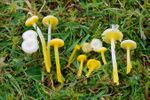 |
Gloioxanthomyces vitellinus | Glistening Waxcap | endangered |
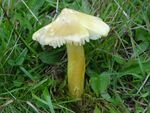 |
Hygrocybe citrinovirens | Citrine Waxcap | vulnerable |
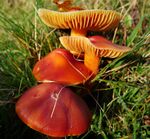 |
Hygrocybe punicea | Crimson Waxcap | vulnerable |
 |
Hygrocybe spadicea | Date Waxcap | vulnerable |
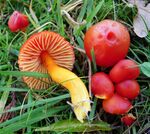 |
Hygrocybe splendidissima | Splendid Waxcap | vulnerable |
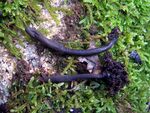 |
Microglossum atropurpureum | Dark-purple Earthtongue | vulnerable |
| Neohygrocybe ingrata | Dingy Waxcap | vulnerable | |
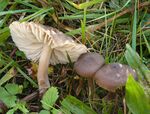 |
Neohygrocybe nitrata | Nitrous Waxcap | vulnerable |
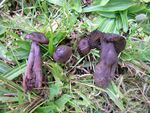 |
Neohygrocybe ovina | Blushing Waxcap | vulnerable |
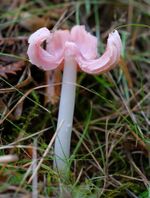 |
Porpolomopsis calyptriformis | Pink Waxcap | vulnerable |
| Pseudotricholoma metapodium | Mealy Meadowcap | endangered | |
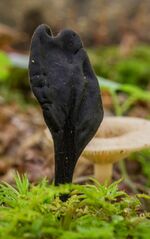 |
Trichoglossum walteri | Short-spored Earthtongue | vulnerable |
Conservation in the United Kingdom
In the United Kingdom, survey work has shown that surviving waxcap grasslands are more extensive than in many other European countries, thanks mainly to large areas of unimproved upland sheep pastures and also to many unimproved lawns (especially in churchyards and country houses) and amenity grasslands.[10] Nonetheless, five species characteristic of waxcap grasslands - Entoloma bloxamii, Porpolomopsis calyptriformis, Hygrocybe spadicea, Microglossum atropurpureum, and Microglossum olivaceum - were formerly the subject of national Biodiversity Action Plans[11] and waxcap grasslands as a specific habitat were the subject of several local Biodiversity Action Plans.[12][13] Four species - E. bloxamii, H. spadicea, M. atropurpureum, and M. olivaceum - are currently listed as "Priority Species" under Section 41 of the Natural Environment and Rural Communities Act (in England)[14] and Section 7 of the Environment (Wales) Act (in Wales).[15]
JNCC (Joint Nature Conservation Committee) has issued "Guidelines for the Selection of Biological SSSIs" (Sites of Special Scientific Interest) that offer a measure of protection to waxcap grasslands. Using the "CHEGD" system, sites should be considered for notification as SSSIs if the total number of waxcap species reaches or exceeds 19. Thresholds are also stipulated for other CHEGD species.[16] As a result, several waxcap-grassland sites, such as the banks of Llanishen and Lisvane Reservoirs in Cardiff[13][17] Down Farm in Dorset,[18] The Leasowes in Shropshire,[19] and the lawns of Roecliffe Manor in Leicestershire,[20] have been designated Sites of Special Scientific Interest.
Waxcap grassland surveys have been undertaken by the British Mycological Society,[6] the National Trust,[21] Plantlife,[22] and the various national conservation bodies.[23][24] A leaflet on managing waxcap grasslands in Britain and Ireland has been published by Plantlife and the Fungus Conservation Forum.[25]
References
- ↑ 1.0 1.1 "Fungi: The IUCN Red List of Threatened Species". https://www.iucnredlist.org/search?taxonomies=100001&searchType=species.
- ↑ Schweers ACS. (1949). "Hygrophorusweide, een associatie". Fungus 19: 17–18.
- ↑ 3.0 3.1 Arnolds E. (1988). "The changing macromycete flora in the Netherlands". Transactions of the British Mycological Society 90 (3): 391–406. doi:10.1016/s0007-1536(88)80148-7.
- ↑ 4.0 4.1 4.2 Arnolds E. (1989). "The influence of increased fertilization on the macrofungi of a sheep meadow". Opera Botanica 100: 7–21.
- ↑ 5.0 5.1 Rald E. (1995). "Vokshatte som indikatorarter for mykologisk verifulde overdrevslokaliteter". Svampe 11: 57–65.
- ↑ 6.0 6.1 6.2 "Waxcap-grassland survey". The Mycologist 10: 23–25. 1996. doi:10.1016/s0269-915x(96)80046-2.
- ↑ 7.0 7.1 7.2 "Ecology and diversity of waxcap (Hygrocybe spp) fungi" (DOC). Botanical Journal of Scotland 54: 7–22. 2002. doi:10.1080/03746600208685025. http://www.aber.ac.uk/waxcap/downloads/ecology-diversity.doc.
- ↑ 8.0 8.1 Griffith, Gareth W.; Roderick, Kevin; Graham, Andrew; Causton, David R. (January 2012). "Sward management influences fruiting of grassland basidiomycete fungi". Biological Conservation 145 (1): 234–240. doi:10.1016/j.biocon.2011.11.010. ISSN 0006-3207.
- ↑ https://cieem.net/grasslands-and-chegd-fungi/
- ↑ 10.0 10.1 Griffith, G.W.; Gamarra, J.G.P.; Holden, E.M.; Mitchel, D.; Graham, A.; Evans, D.A.; Evans, S.E.; Aron, C. et al. (30 August 2014). "The international conservation importance of Welsh 'waxcap' grasslands". Mycosphere 4 (5): 969–984. doi:10.5943/mycosphere/4/5/10.
- ↑ UK BAP priority fungi species http://jncc.defra.gov.uk/page-5165
- ↑ waxcap grassland action plan https://neenp.org.uk/natural-environment/durham-priority-habitats/waxcap-grassland-action-plan/
- ↑ 13.0 13.1 Provisional atlas of waxcap fungi Hygrocybe in Cardiff https://www.aber.ac.uk/waxcap/downloads/Grantham-CardiffWaxcapAtlas2009.pdf
- ↑ "Section 41 Species - Priority Actions Needed (B2020-008)". Natural England. October 2013. http://publications.naturalengland.org.uk/publication/4958719460769792.
- ↑ Section 7 Priority Species https://www.biodiversitywales.org.uk/environment-wales-act
- ↑ Guidelines for the Selection of Biological SSSIs: Chapter 14: Non-lichenised Fungi https://data.jncc.gov.uk/data/d1fcb171-8086-4f5b-ade5-a34c5edc78c5/SSSI-Guidelines-14-Non-lichenisedfungi-2018a.pdf
- ↑ Llanishen and Lisvane Reservoirs: Ecology http://www.friendsofcardiffreservoirs.org/ecology/
- ↑ Down Farm SSSI https://consult.defra.gov.uk/natural-england/down-farm/supporting_documents/Down_Farm_Supporting_Info_final%20notified%207%20Feb%202019.pdf
- ↑ The Leasowes https://www.dudley.gov.uk/news/rare-mushrooms-to-get-special-protection-at-halesowen-beauty-spot/
- ↑ Roecliffe Manor SSSI https://pap.charnwood.gov.uk/AnitePublicDocs/00135127.pdf
- ↑ Grassland Fungi Project https://www.nationaltrust.org.uk/hardcastle-crags/features/grassland-fungi-project
- ↑ Waxcap Watch//https://www.plantlife.org.uk/uk/discover-wild-plants-nature/habitats/grassland/waxcaps-fungi/waxcapp-survey
- ↑ Evans S (2003). "Waxcap-grasslands - an assessment of English sites". English Nature Research Reports 555: 1–49. http://publications.naturalengland.org.uk/publication/131003#:~:text=Waxcap%2Dgrasslands%20%E2%80%93%20an%20assessment%20of%20English%20sites%20(ENRR555),England%20on%2012%20May%202004%20.&text=Waxcap%2Dgrassland%20fungi%20are%20of,throughout%20the%20UK%20and%20Europe..
- ↑ Scottish Fungi - grassland fungi project http://sites.google.com/site/scottishfungi/conservation/grassland-fungi
- ↑ Anon. Grassland gems: managing lawns and pastures for fungi (leaflet). Plantlife. pp. 4. https://www.plantlife.org.uk/application/files/3414/8232/2984/Grassland_gems-_managing_lawns_and_pastures_for_fungi.pdf.
External links
- WaxCap Website, University of Wales, Aberystwyth.
 |
 KSF
KSF